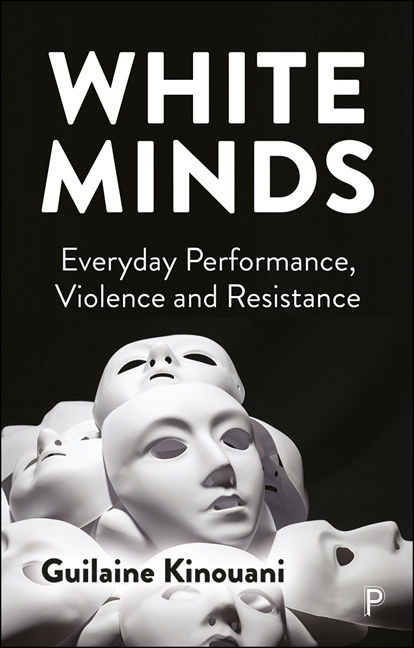Book contents
- Frontmatter
- Dedication
- Contents
- Acknowledgements
- Preface
- Note on language
- Introduction
- 1 Whiteness, time and space
- 2 White gazes
- 3 White envy
- 4 White sadism
- 5 White trauma
- 6 White dissociation
- 7 White shame
- 8 White ambivalence
- 9 White complicity
- Whiteness and resistance: by way of conclusion
- References
- Index
6 - White dissociation
Published online by Cambridge University Press: 28 March 2024
- Frontmatter
- Dedication
- Contents
- Acknowledgements
- Preface
- Note on language
- Introduction
- 1 Whiteness, time and space
- 2 White gazes
- 3 White envy
- 4 White sadism
- 5 White trauma
- 6 White dissociation
- 7 White shame
- 8 White ambivalence
- 9 White complicity
- Whiteness and resistance: by way of conclusion
- References
- Index
Summary
I was socialised … not to see myself as connected to racism and certainly not to see myself as connected to race. In other words, I did not have a sense of a racial identity. Today, I understand that I move through the world always and most particularly as a white person. I have a white frame of reference and I have a white experience. And part of being white is to have that be invisible to ourselves and to be able to live our lives without ever acknowledging that, to see that as non-operative.
(DiAngelo, 2017 [1])Di-Angelo’s words provide a white context to Eddo-Lodge’s book Why I’m no longer talking to white people about race. Specifically the racialised context to the disconnection that can follow cross-racial exchanges. As a woman writer racialised as black, Eddo-Lodge refers to ‘the gulf of an emotional disconnect’ which translates to recognisable difficulties in being seen, heard and understood. She names what people racialised as black often experience when they attempt to articulate matters related to race. In the previous chapter, we proposed that whiteness may be reiterated through unprocessed traumatic responses, responses which might continue to be transmitted from generation to generation. In Chapter 4 we have seen that lynching was used as a method of social and economic control. We referenced the grotesque pictures of lynching scenes on postcards which depicted jovial and carefree white audiences posing next to black bodies, often hanging, in pieces, from trees. Reconciling the joyful mood of these audiences with the gruesome violent acts committed may seem impossible, even after the examination of sadism. Dissociation and splitting offer analytic tools to help do just that.
Splitting and dissociation
The intoxicating influence of Whiteness creates a vapid space in which thinking is impeded – defended against.
(Dennis, 2022 [2])The defences of splitting and dissociation which keep white ignorance and white benevolence intact in fact strengthen the case for white trauma. But since maintaining the status quo requires some disconnection from the status quo, the distance created by splitting and dissociation illuminates the temporality of whiteness and its links with dominant ideologies and epistemic practices in the West.
- Type
- Chapter
- Information
- White MindsEveryday Performance, Violence and Resistance, pp. 101 - 113Publisher: Bristol University PressPrint publication year: 2023

